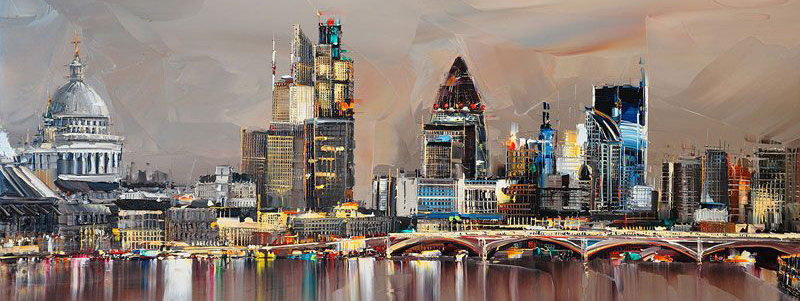Kensington - Belgravia - Pimlico - Victoria - Marylebone
The three jewels of regent's park - Paddington
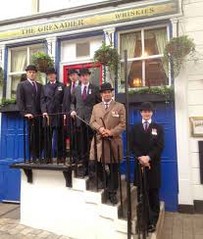 At number 18 of the nearby Wilton Row, at the corner of Old Barrack Yard, at the end of a small paved one-way street where there were once stables, stands the patriotic Grenadier pub, painted in red, white, and blue. In front of its facade, there is a gas lamp, a sentry box, and some hanging flower baskets. A small flight of stairs leads to a cosy and comfortable room with a chrome-plated bar full of stains, which is four hundred years old. The pub is filled with military memorabilia, and haunted by the ghost of a soldier who was whipped to death by his fellow players upon being caught cheating at a card game. An excellent Bloody Mary is served here, and at the back there is a graceful little restaurant room.
At number 18 of the nearby Wilton Row, at the corner of Old Barrack Yard, at the end of a small paved one-way street where there were once stables, stands the patriotic Grenadier pub, painted in red, white, and blue. In front of its facade, there is a gas lamp, a sentry box, and some hanging flower baskets. A small flight of stairs leads to a cosy and comfortable room with a chrome-plated bar full of stains, which is four hundred years old. The pub is filled with military memorabilia, and haunted by the ghost of a soldier who was whipped to death by his fellow players upon being caught cheating at a card game. An excellent Bloody Mary is served here, and at the back there is a graceful little restaurant room.Statue – In Hyde Park there are a great number of sculptures and the area is something of an open-air museum. Near to the old Wellington house, known as Apsley House (the post code was once: Number 1, London), there is a colossal bronze statue of Achilles.
It was carried out in 1822 by Westmacott in memory of the Duke of Wellington. The metal used for constructing it was recovered from twelve French cannons captured in the battles of Salamanca, Victoria, Toulouse, and Waterloo. For Wellington’s pose, the sculptor drew inspiration from the statues of the Horse Tamers at the Quirinale, however the nudity of the muscular figure was quite a scandal for public opinion at the time.
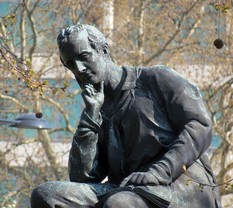
On the pedestal there is a citation dedicated to the general and his companions. Along the South Carriage Drive, which runs parallel to Knightsbridge, there is a statue of Byron discovered in 1880 and carried out by Richard Belt. The great poet is represented in the company of his faithful dog.
The marble pedestal of the statue was provided by the Greek government, and weighs fifty-seven tons. Beneath the trees of Park Lane, stands the fountain of Huxley Jones, known as The Joy of Life, a concept expressed by the statues which are portrayed in the act of hopping between the spurts of water.
HYDE PARK CORNER
PARK LANE, BAYSWATER ROAD
UNDERGROUND: MARBLE ARCH, LANCASTER GATE
In 1637, Charles I was the first king to open Hyde Park to the public and create the Ring, the rough and sandy track trodden by horses and carts. In the north-eastern corner of the park stands Marble Arch, an arch built in 1827 by John Nash and inspired by the arch of Constantine in Rome. Marble Arch was supposed to be located in front of Buckingham Palace, which had just been built for George IV. In the spot where Carriage Drive veers southwards and takes on the name of The Ring, and where the stretch of water known as Long Water begins, stands the eighteenth-century Queen Anne’s Alcove, which has been moved here from Marlborough Gate. This gracious little temple was probably designed by Wren and was destined for the garden of a country house. It has four great Corinthian pillars, and on the inside it is covered with curved panels in dark wood.
If one starts to feel thirsty after listening to the speeches, at number 29 of the nearby Crawford Place, one can seek a quenching in the Windsor Castle Pub. The name indicates the fact that the indoor area is full of memorabilia connected to the royal family, which are boasted with outright ostentation.
Because of this, it tends to feel a little kitsch, yet at the same time, it is peculiar and unique. It was opened by a TV actress, Wendy Richard. Today, as well as the traditional fish and chips, there are also some Thai dishes: from one monarchy to another
THE BIRD RESERVE
HYDE PARK,
UNDERGROUND: MARBLE ARCHThe reserve was created in 1925 in memory of W.H. Hudson, who died in 1922. There is also a great parallelepiped in stone, with a bas-relief by Epstein, which represents Rima, a being which is half man, half spirit of the woods. This too is a homage to Hudson, due to the fact that Rima is one of the characters of his book Green Mansions. The central sculpture of the bas-relief by Epstein, which portrays a maid surrounded by birds, was not greatly appreciated at the time, and was smeared a number of times with green paint. Today it is judged that Epstein’s work expresses the power and ferocity of nature. There are dozens of different types of birds in the reserve, such as herons, ducks of all sizes, and great crested grebes.
THE PET CEMETERY
VICTORIA GATEUNDERGROUND: LANCASTER GATE
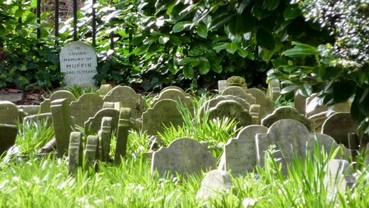 Near Victoria Gate’s western exit, at the corner with Bayswater, there lies a pet cemetery, where family animals were buried between 1880 and the Great War. Behind the gates one can still see the tombstones covered in moss. The cemetery has been closed since 1915, although an exception was made in 1967 for a small dog, as she was the mascot of a company of Royal Marines. There are many cultures where it was and still is a custom to bury animals with a ceremony and in reserved areas when they are considered important or have an emotional or sacred significance. The Egyptians used to do so, and they would erect funeral monuments for cats, which were considered to be sacred animals. Here, along with dogs and cats, also some birds and a monkey lie buried as well. Some of the inscriptions on the tombs are similar to those that one might write out for a dead relative.
Near Victoria Gate’s western exit, at the corner with Bayswater, there lies a pet cemetery, where family animals were buried between 1880 and the Great War. Behind the gates one can still see the tombstones covered in moss. The cemetery has been closed since 1915, although an exception was made in 1967 for a small dog, as she was the mascot of a company of Royal Marines. There are many cultures where it was and still is a custom to bury animals with a ceremony and in reserved areas when they are considered important or have an emotional or sacred significance. The Egyptians used to do so, and they would erect funeral monuments for cats, which were considered to be sacred animals. Here, along with dogs and cats, also some birds and a monkey lie buried as well. Some of the inscriptions on the tombs are similar to those that one might write out for a dead relative.ON THE LAKE ON A SOLAR SHUTTLE
HYDE PARK
UNDERGROUND
It was Queen Caroline, wife of George II, who decided that the park needed a lake in order to enhance its beauty, and as the Westbourne river was nearby, an affluent of the Thames which passed through the park, works were commenced to excavate it and build a dam. Thus, Lake Serpentine was created in 1736, and caused a flood in the Knightsbridge and Belgravia neighbourhoods. The Thames boatmen, taking advantage of the situation, started to offer boat rides through the flooded but elegant neighbourhoods of the wealthy. 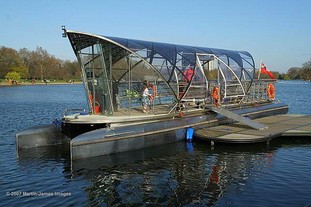 Today, as well as the chance to rent a paddle boat or a rowing boat in order to move around on the lake, there is also the option of going for a ride on the Solar Shuttle. The latter is a watercraft which is powered by solar panels installed on the rooftop and via a solar engine. The cruising speed only reaches eight kilometres per hour, however during the half hour needed to go from one bank to the other, one can admire the countryside at one’s leisure, and it really is worth it.
Today, as well as the chance to rent a paddle boat or a rowing boat in order to move around on the lake, there is also the option of going for a ride on the Solar Shuttle. The latter is a watercraft which is powered by solar panels installed on the rooftop and via a solar engine. The cruising speed only reaches eight kilometres per hour, however during the half hour needed to go from one bank to the other, one can admire the countryside at one’s leisure, and it really is worth it.
 Today, as well as the chance to rent a paddle boat or a rowing boat in order to move around on the lake, there is also the option of going for a ride on the Solar Shuttle. The latter is a watercraft which is powered by solar panels installed on the rooftop and via a solar engine. The cruising speed only reaches eight kilometres per hour, however during the half hour needed to go from one bank to the other, one can admire the countryside at one’s leisure, and it really is worth it.
Today, as well as the chance to rent a paddle boat or a rowing boat in order to move around on the lake, there is also the option of going for a ride on the Solar Shuttle. The latter is a watercraft which is powered by solar panels installed on the rooftop and via a solar engine. The cruising speed only reaches eight kilometres per hour, however during the half hour needed to go from one bank to the other, one can admire the countryside at one’s leisure, and it really is worth it.This is a form of technology which is harmless for the environment, and offers rest, amusement, and relaxation in a friendly and safe environment. Since 2008, there has also been an area for boat storage.
THE INDIAN CARRIAGES OF THE RATHA YATRA FESTIVAL
HYDE PARK CORNER, TRAFALGAR SQUAREUNDERGROUND: LANCASTER GATE
This spectacular Indian festival which is in honour of Krishna, and has been celebrated for as many as five thousand years in Orissa, usually takes place between the second and third Sunday of June, and lasts all day. The parade, organized by the International Society for Krishna Consciousness, celebrates Indian culture and spiritual life. The three great wooden carriages are towed by hand by a crowd of pilgrims and followers, and on them the Hindu divinities stand wearing togas, and are said to have “come out of the temple to grace everyone with their loving gaze.” Other followers of the faith accompany the parade with songs, music, and dances. Along the way, many of the devoted attempt to tug on the ropes that hang down the sides of the carriage, as it is believed that this act will grant them eternal service to the Creator in the afterlife.
In Trafalgar Square there are many stands selling books and products of craftwork, as well as musical workshops and stands where one may learn to drape sari. There are special offers on the prasadam and other vegetarian dishes for participants.
LIBRARY BAR
LANESBOROUGH HOTEL
UNDERGROUND: HYDE PARK CORNER
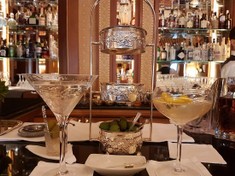 Celebrities often come here to refresh their general knowledge and culture, as well as to enjoy the live music, armed with a cocktail to sip slowly. Unfortunately, anyone not dressed elegantly enough may not enter.
Celebrities often come here to refresh their general knowledge and culture, as well as to enjoy the live music, armed with a cocktail to sip slowly. Unfortunately, anyone not dressed elegantly enough may not enter.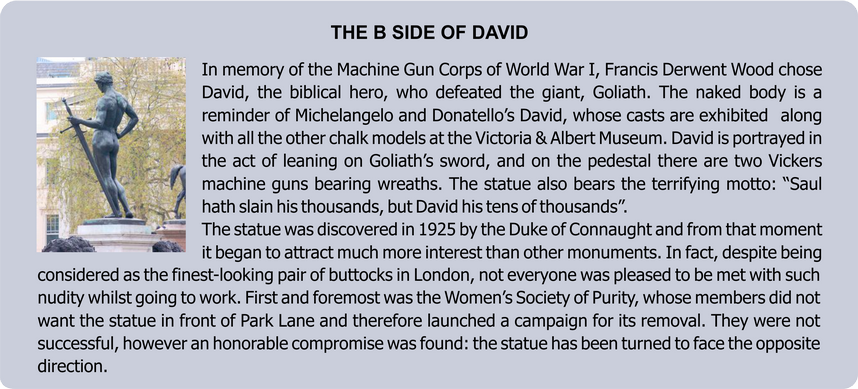
The ancient Latin name of what was once the vast land property of Abingdon Abbey was Chenesitone. The area has its commercial heart in Kensington High Street and its cultural heart in the musical district of South Kensington.
The Kensington Gardens park is west of Hyde Park, and separated from it by the Serpentine. On a cross street of High Street Kensington, runs the Kensington Church Walk. The path entrance is next to the old town hall, and it leads to a peaceful pedestrian passage in York stone, where there stands a row of little shops, selling antique furniture and books, with a delightful little courtyard at the back. There are also a few benches to sit on and take in the sound of the birds singing.
AMIDST GORGES AND ROTTEN ROADS
HYDE PARK
UNDERGROUND: HYDE PARK CORNER
The street that runs across Hyde Park and heads towards the Flower Walk is called Rotten Row, meaning “rotten street”. In truth, the name is in fact a deformation of the French route du roi, meaning “the king’s path”. It used to connect Kensington Palace with Hyde Park and was large enough for carts to travel on
It was Queen Caroline, wife of George II, who had the river Westbourne barred, had a series of ponds linked together, and who created the Serpentine. An engraving reminds us that there was once a water source here, which was one of the points of water supply for Westminster. It existed as early as 1066, before the Norman invasion, and remained in use until 1861. At the extremity of the Serpentine stands the Dell bar, which is a granite monolith which weighs seven tons and was originally part of a fountain. A nearby stone bears the inscription in memory of the Westminster monks who once used to get their water from a source which gushed forth in this spot. A garden has now been grown around it.
The bridge between Long Water and the Serpentine was designed by John and George Rennie in 1826.
SERPENTINE GALLERY
KENSINGTON GARDENS
UNDERGROUND: LANCASTER GATE, SOUTH KENSINGTON
The gallery was opened in 1970 in order to exhibit the work of young artists, not only of English origin.
The Pavilion, instead, dates back to 2008 and was designed by Frank Gehry. It is a spectacular building, formed by large beams, steel pillars, and a network of overlapping glasswork. All these elements, seemingly casual, create a multidimensional space. In the daytime, one can relax and ponder, whereas in the evening one can attend debates and shows. Each year the model of the structure changes.
FLOWER WALK
VICTORIA GATE
UNDERGROUND: HYDE PARK CORNER
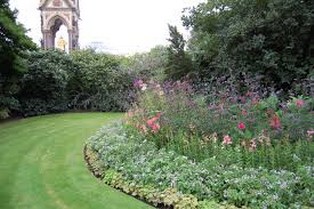 When the writer Henry James used to come for walks in Hyde Park, one could hear the bleating of lambs, as he himself recounts. Today the herds of sheep are no longer to be found, but there are some wonderful paths such as this one for some pleasant walks. Along this particular path, one can often see young people having fun climbing up the crooked branches of
When the writer Henry James used to come for walks in Hyde Park, one could hear the bleating of lambs, as he himself recounts. Today the herds of sheep are no longer to be found, but there are some wonderful paths such as this one for some pleasant walks. Along this particular path, one can often see young people having fun climbing up the crooked branches ofstrangely-shaped ancient trees.
THE GOD PAN
KENSINGTON GARDENS
UNDERGROUND: KNIGHTSBRIDGE
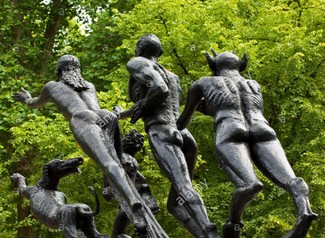 Near Edinburgh Gate, there is a work in bronze carried out by Epstein which represents the god Pan, intent on playing a pipe in front of a family bearing the appearance of people who have somehow grown accustomed to living in the wild. Also present is a dog, portrayed in the act of bounding and barking. For Pagan cults, Pan was a divinity who appeared in a goat-like form, with furry hind legs and hooves, a bearded face, and horns. This work was placed here in 1961. Its meaning lies in this divinity’s role as a guide, to whom the family happily submit their will, surrounded by the freedom of the park. This happiness is also shared by the dog, who follows them, rolling and lolloping. The author, Epstein, was American by birth, although the son of Polish refugees. He was a pioneer of modern sculpture and worked mainly in England.
Near Edinburgh Gate, there is a work in bronze carried out by Epstein which represents the god Pan, intent on playing a pipe in front of a family bearing the appearance of people who have somehow grown accustomed to living in the wild. Also present is a dog, portrayed in the act of bounding and barking. For Pagan cults, Pan was a divinity who appeared in a goat-like form, with furry hind legs and hooves, a bearded face, and horns. This work was placed here in 1961. Its meaning lies in this divinity’s role as a guide, to whom the family happily submit their will, surrounded by the freedom of the park. This happiness is also shared by the dog, who follows them, rolling and lolloping. The author, Epstein, was American by birth, although the son of Polish refugees. He was a pioneer of modern sculpture and worked mainly in England.SUNKEN GARDENS
KENSINGTON GARDENS
UNDERGROUND: HIGH STREET KENSINGTON
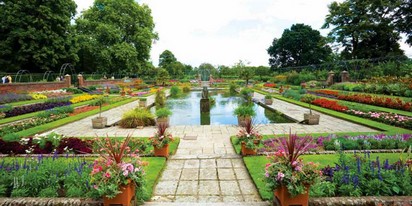 Despite the literal wording of “sunken garden”, the name actually indicates an artificial garden, often including rocks and stones. That of Kensington, in particular, has been created from an area where there were once sheds for tools, and it is now an oasis of tranquillity. It was created in 1909, during the reign of King Edward VII, and is based on a Tudor garden in Hampton Court. The vividly coloured flowers in the ornamental flowerbeds are replaced with each new season. In Spring there are tulips and pansies, whilst the Summer brings geraniums and begonias, which surround the little lake with the spurting of fountains. At its origin, the garden was encircled by an elevated trellis known as Cradle Walk, from which one can look down onto the flowers and the water’s surface. Unfortunately, on 16th October, 1987, it was damaged irreversibly by a storm, and had to be cut down. Pepys described it as: “a fine cool place with a great layer of water in the middle”.
Despite the literal wording of “sunken garden”, the name actually indicates an artificial garden, often including rocks and stones. That of Kensington, in particular, has been created from an area where there were once sheds for tools, and it is now an oasis of tranquillity. It was created in 1909, during the reign of King Edward VII, and is based on a Tudor garden in Hampton Court. The vividly coloured flowers in the ornamental flowerbeds are replaced with each new season. In Spring there are tulips and pansies, whilst the Summer brings geraniums and begonias, which surround the little lake with the spurting of fountains. At its origin, the garden was encircled by an elevated trellis known as Cradle Walk, from which one can look down onto the flowers and the water’s surface. Unfortunately, on 16th October, 1987, it was damaged irreversibly by a storm, and had to be cut down. Pepys described it as: “a fine cool place with a great layer of water in the middle”. ORANGERY
KENSINGTON GARDENS
UNDERGROUND: HIGH STREET KENSINGTON
The Eighteenth-century Orangery by Nicholas Hawksmoor now hosts a restaurant.
Within its airy building, with an extremely high ceiling and stone flooring, the tables and chairs are black, made in iron, and the starched napkins are of an immaculate white. If one sits at a long table along the back wall, one can take in the beautiful sight of the perfectly arranged baroque garden. The restaurant is expensive, and if one does not wish to spend much, one can come here to enjoy a tea along with a couple of delicious tarts, whilst reading a book. Then, if the weather is nice, one may continue one’s reading on one of the deck chairs near the Round Pond, and gaze up from time to time to admire the graceful swans which glide by.
KENSINGTON PALACE
KENSINGTON GARDENS
UNDERGROUND: HIGH STREET KENSINGTON
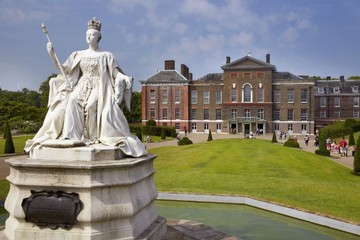 Today Kensington Palace is mostly known for having been the home of Lady Diana. However, until the construction of Buckingham Palace, it was a royal residence. It was acquired by King William and Queen Mary in 1689, as a country residence, following his respiratory ailments. It was originally a manor house, and it was later modified by Christopher Wren and Hawksmoor, who redesigned its architecture. It stood in the village of Kensington and was the birthplace of Queen Victoria.
Today Kensington Palace is mostly known for having been the home of Lady Diana. However, until the construction of Buckingham Palace, it was a royal residence. It was acquired by King William and Queen Mary in 1689, as a country residence, following his respiratory ailments. It was originally a manor house, and it was later modified by Christopher Wren and Hawksmoor, who redesigned its architecture. It stood in the village of Kensington and was the birthplace of Queen Victoria.One of the most beautiful and important rooms is the Cupola Room, designed by William Kent in 1722, which has a ceiling simulating the coffered type. The most important part is the monumental musical clock, upon which arias by Händel, Corelli, and Geminiani were once played. The King’s Gallery, painted by William Kent in 1725 with scenes taken from the Odyssey, and the public rooms, painted by Colin Campbell for George I in 1718 are also open to the public. Inside, there is a collection of ceremonial and court clothing. It is interesting to reach it via Kensington Palace Green, where an ancient entrance stands, dating back to the XVIII Century.
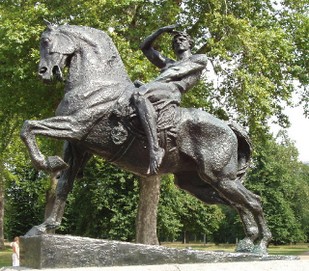 Statues - Amongst the statues of Kensington Gardens, there is a bronze by G. Watts, dated 1908, which goes by the title Phisical Energy and portrays a man on a horse, the latter stamping its hoof on the ground, impatient to set off. The statue, of which this is a copy, forms the central part of the monument dedicated to Cecil Rhodes on Table Mountain, near Cape Town. The copy was placed here in 1904.
Statues - Amongst the statues of Kensington Gardens, there is a bronze by G. Watts, dated 1908, which goes by the title Phisical Energy and portrays a man on a horse, the latter stamping its hoof on the ground, impatient to set off. The statue, of which this is a copy, forms the central part of the monument dedicated to Cecil Rhodes on Table Mountain, near Cape Town. The copy was placed here in 1904.South of the Flower Walk is also the Albert Memorial, a funeral monument which is both imposing and elaborate. It is something of a gigantic medieval reliquary, each of its details inspiring one of the interests of Prince Albert of Saxony. At its centre, beneath the steeple, there is a statue of the prince depicted as he reads the catalogue of the Great Exhibition. At its corners, there are four groups symbolizing the continents. Along its base, there is a frieze made up of dozens of figures in the form of a bas-relief. There are sculptors, musicians, poets, and painters, such as Raphael, Michelangelo, Giotto, and Cimabue. Also present, are Ghiberti and Luca della Robbia. Female figures are completely absent.
PARK LANE
BETWEEN HYDE PARK CORNER AND MARBLE ARCH
UNDERGROUND: HYDE PARK CORNER
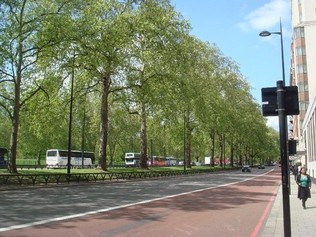 There was a time when Park Lane was the place where all the elegant noble residences once stood, whereas today it is mostly an area of hotels. Grosvenor House and Dorchester House used to be there, built half way through the Nineteenth Century with a facade modelled by following that of the Villa Farnesina by Peruzzi, in Rome. It took fifteen years to carry out the decorations of the dining room. When the house was later demolished, a part of it was moved to the Walker Art Gallery in Liverpool. The chimney was instead, with its caryatides inspired by Michelangelo’s work, is to be found in the Gamble Room of the Victoria & Albert Museum.
There was a time when Park Lane was the place where all the elegant noble residences once stood, whereas today it is mostly an area of hotels. Grosvenor House and Dorchester House used to be there, built half way through the Nineteenth Century with a facade modelled by following that of the Villa Farnesina by Peruzzi, in Rome. It took fifteen years to carry out the decorations of the dining room. When the house was later demolished, a part of it was moved to the Walker Art Gallery in Liverpool. The chimney was instead, with its caryatides inspired by Michelangelo’s work, is to be found in the Gamble Room of the Victoria & Albert Museum. 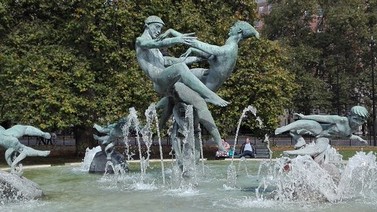 In a nearby villa, some of Canova’s statues were exhibited to the public until 1962, then they were sold on auction by Sotheby’s when the house was demolished.
In a nearby villa, some of Canova’s statues were exhibited to the public until 1962, then they were sold on auction by Sotheby’s when the house was demolished.On the greener side of Park Lane stands the fountain of Huxley Jones, with an enormous bowl, which holds the bronze figures of many adults and children portrayed in the act of skipping and jumping with joy. It is aptly known as The Joy of Life.
THE GNOMES ON THE STUMP
KENSINGTON GARDENS
UNDERGROUND: HIGH STREET KENSINGTON
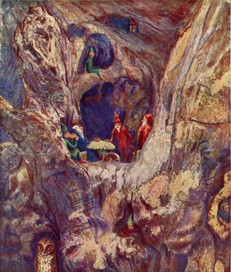 If one walks north until the extremity of Broad Walk, one will come across the Elfin Oak. In 1911, the sculptor Ivor Innes carved the natural knots and bulges of the enormous stump belonging to a nine-hundred-year-old tree, in such a way as to depict the shapes evoked by his imagination. There are elves, witches, frogs, foxes, rabbits, fairies, and gnomes, all of them enclosed in a large aviary. There are also mysterious doors which open up on the tree trunk.
If one walks north until the extremity of Broad Walk, one will come across the Elfin Oak. In 1911, the sculptor Ivor Innes carved the natural knots and bulges of the enormous stump belonging to a nine-hundred-year-old tree, in such a way as to depict the shapes evoked by his imagination. There are elves, witches, frogs, foxes, rabbits, fairies, and gnomes, all of them enclosed in a large aviary. There are also mysterious doors which open up on the tree trunk.The sculptor took care of its maintenance for over forty years. In 1996, the wee tree was restored.
This sculpture appeared in the background of David Gilmour’s photo on the inside cover of Pink Floyd’s Ummagumma album, dated 1969 (aside from the extremely young, many will remember this).
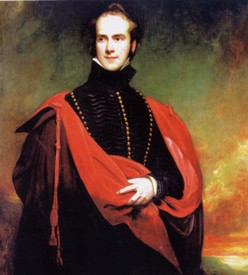 Its name derives from that of the Viscount of Belgrave, as this is in fact a village belonging to Cheshire. Most of the constructions consist of rows of houses of a most immaculate white, with pillars between the first and second floors. Belgrave Square and Eaton Square are its centres. The former was once part of the property belonging to Richard Grosvenor, who was the Marquise of Westminster. His rows of white houses were built by Thomas Cubitt; they are not interrupted by the streets which lead in from the corners of the square. This is one of the prettiest residential areas in the capital, extremely peaceful and quiet. In its centre are some very tall trees, which do not allow for a complete view of the building’s facades.
Its name derives from that of the Viscount of Belgrave, as this is in fact a village belonging to Cheshire. Most of the constructions consist of rows of houses of a most immaculate white, with pillars between the first and second floors. Belgrave Square and Eaton Square are its centres. The former was once part of the property belonging to Richard Grosvenor, who was the Marquise of Westminster. His rows of white houses were built by Thomas Cubitt; they are not interrupted by the streets which lead in from the corners of the square. This is one of the prettiest residential areas in the capital, extremely peaceful and quiet. In its centre are some very tall trees, which do not allow for a complete view of the building’s facades.Shadows on Belgrave Square is the name of a detective story, written by Anne Perry, which was Juliet Marion Hulme’s pseudonym. She was born in London in 1938, and in her youth had been sentenced to jail for sixteen years for the murder of the mother of a friend of hers, the latter being also an accomplice.
It is definitely pleasant to walk amid the complex of lanes which weave around Groom place and along the cross streets of Kinnerton Street. These are known as mews because the old stables used to stand there, but they were later transformed into cottages. Inside these looming buildings, there are embassies and big trade company headquarters, seeing as the maintenance costs are by now much too steep to be sustained by private owners. Towards Hyde Park Corner, there is an area where St George’s Hospital used to stand, after being opened in 1733. Dr Hunter’s bust once decorated the spot above its entrance: he had died suddenly from a heart attack after a particularly argumentative meeting. In his right hand, he held an anatomical statue, which was said to have been created by Michelangelo. The hospital became famous thanks to one of its students, Dr Henry Gray, author of the book Gray’s Anatomy, who via the method of dissection had discovered the nervous connections in the eye.
CHURCH OF ST PAUL
WILTON PLACE
UNDERGROUND: HYDE PARK CORNER
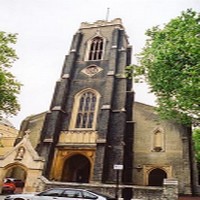 This church is hardly known of at all (and because of this, is peaceful and quiet), albeit being one of the most beautiful Victorian churches in London. It is the work of Thomas Cundy the Younger, who built it in 1843, and it was designed in the neo-Gothic style. The vast galleries are sustained by pillars of cast iron, the choir is separated by an elaborate reredos, and the walls bear panels depicting the life of Christ. The most impressive part, however, is the painted wooden ceiling. The church stands at the centre of the Grosvenor Estate and is definitely worth a visit.
This church is hardly known of at all (and because of this, is peaceful and quiet), albeit being one of the most beautiful Victorian churches in London. It is the work of Thomas Cundy the Younger, who built it in 1843, and it was designed in the neo-Gothic style. The vast galleries are sustained by pillars of cast iron, the choir is separated by an elaborate reredos, and the walls bear panels depicting the life of Christ. The most impressive part, however, is the painted wooden ceiling. The church stands at the centre of the Grosvenor Estate and is definitely worth a visit.The second, Eaton Square, is one of the three garden squares built by the Grosvenor family. It is not exactly an actual square, as it is long and narrow. Over one hundred houses look out onto it, all designed by Cubitt and completed in 1855. Some of them are in white plaster, others in brick, all with a view looking out onto a common garden. At the eastern end of the square stands St Peter’s church, designed in 1824 by Henry Hakewill, and it was the first building to be completed.
The Pimlico area is the most modest one in Belgravia. It was once a marsh, described in Trollope’s novel, The Small House at Allington. It is said that the name comes from that of Ben Pimlico, who once produced a kind of nut-coloured ale, the recipe for which has been lost with the passing of the centuries.
Pimlico has an unusual atmosphere; it is easy-going and unconventional. South of Victoria Station, its Regency architecture is very pleasing to behold. At its centre is the so-called Grid, a pretty residential area. 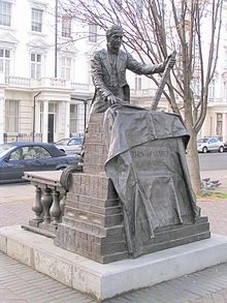 Many of the houses have become small hotels or B&Bs, and the plaster is no longer white, but has vivid and varied hues. Thomas Cubitt designed the network of streets at an angle of 45° to the river, and at each corner he placed a curved facade, acting as a pivot for each of the streets projecting away from it. In Denbigh Street there is a beautiful statue dedicated to him, which portrays him holding the tools of the trade. The statue was created by William Fawke. There are a number of great tree-laden squares, such as Warwick Square, where the church of St Gabriel stands, its extremely tall steeple standing out between the leafy branches of the trees.
Many of the houses have become small hotels or B&Bs, and the plaster is no longer white, but has vivid and varied hues. Thomas Cubitt designed the network of streets at an angle of 45° to the river, and at each corner he placed a curved facade, acting as a pivot for each of the streets projecting away from it. In Denbigh Street there is a beautiful statue dedicated to him, which portrays him holding the tools of the trade. The statue was created by William Fawke. There are a number of great tree-laden squares, such as Warwick Square, where the church of St Gabriel stands, its extremely tall steeple standing out between the leafy branches of the trees.
 Many of the houses have become small hotels or B&Bs, and the plaster is no longer white, but has vivid and varied hues. Thomas Cubitt designed the network of streets at an angle of 45° to the river, and at each corner he placed a curved facade, acting as a pivot for each of the streets projecting away from it. In Denbigh Street there is a beautiful statue dedicated to him, which portrays him holding the tools of the trade. The statue was created by William Fawke. There are a number of great tree-laden squares, such as Warwick Square, where the church of St Gabriel stands, its extremely tall steeple standing out between the leafy branches of the trees.
Many of the houses have become small hotels or B&Bs, and the plaster is no longer white, but has vivid and varied hues. Thomas Cubitt designed the network of streets at an angle of 45° to the river, and at each corner he placed a curved facade, acting as a pivot for each of the streets projecting away from it. In Denbigh Street there is a beautiful statue dedicated to him, which portrays him holding the tools of the trade. The statue was created by William Fawke. There are a number of great tree-laden squares, such as Warwick Square, where the church of St Gabriel stands, its extremely tall steeple standing out between the leafy branches of the trees.PIMLICO SQUARE
ST GEORGE’S SQUARE
UNDERGROUND: PIMLICO
Next to the Thames, there is a statue of William Huskisson, the unfortunate politician who in 1830, at the opening ceremony of the rail line running between Manchester and Liverpool, was run over and killed by Stephenson’s Rocket train. The sculptor decided to dress him in a robe, considered to be suitable to the dramatic nature of the event.
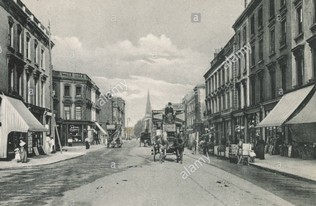 Lupus Street (Lupus was a Latin nickname, which became a name in the Imperial age), gets its name from Hugh Lupus Grosvenor, a man of politics, as well as the owner of the famous racing horses. He owned some vast properties in Mayfair, Belgravia, and Pimlico, and it was said that he was the richest man in the reign. It is also thought that the character of Colonel Ross, created by Conan Doyle for the story called Silver Blaze, may be based on Grosvenor.
Lupus Street (Lupus was a Latin nickname, which became a name in the Imperial age), gets its name from Hugh Lupus Grosvenor, a man of politics, as well as the owner of the famous racing horses. He owned some vast properties in Mayfair, Belgravia, and Pimlico, and it was said that he was the richest man in the reign. It is also thought that the character of Colonel Ross, created by Conan Doyle for the story called Silver Blaze, may be based on Grosvenor.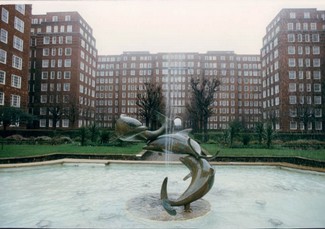 Dolphin Square is one of the first examples of apartment blocks (there are over a thousand) and houses, built in 1935 and now listed buildings. It is a small town, with shops, garages, restaurants, and a central garden. Thirteen houses have been transformed into residences with the names of navigators: Grenville, Drake, Raleigh, Hawkins, Nelson, Howard, Beatty, Duncan, Rodney, Keyes, Hood, Collingwood, and Frobisher. Many MPs reside here, due to its proximity to Westminster.
Dolphin Square is one of the first examples of apartment blocks (there are over a thousand) and houses, built in 1935 and now listed buildings. It is a small town, with shops, garages, restaurants, and a central garden. Thirteen houses have been transformed into residences with the names of navigators: Grenville, Drake, Raleigh, Hawkins, Nelson, Howard, Beatty, Duncan, Rodney, Keyes, Hood, Collingwood, and Frobisher. Many MPs reside here, due to its proximity to Westminster.CHURCHILL GARDENS
CHURCHILL GARDENS ROAD
UNDERGROUND: PIMLICO
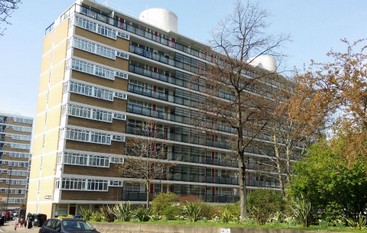 It is not actually a park, but an immense block of public housing apartments, built with poor materials from after the war. Victorian houses once stood in this spot, and were greatly damaged by the bombings. There are one thousand six hundred apartments, located within thirty-two skyscrapers of either ten or twelve floors each, where tens of thousands of people live. In a glass tower, a heat accumulator was placed, which gathered the exhaust warm water from the electric power station of Battersea.
It is not actually a park, but an immense block of public housing apartments, built with poor materials from after the war. Victorian houses once stood in this spot, and were greatly damaged by the bombings. There are one thousand six hundred apartments, located within thirty-two skyscrapers of either ten or twelve floors each, where tens of thousands of people live. In a glass tower, a heat accumulator was placed, which gathered the exhaust warm water from the electric power station of Battersea.Much like the Lillington Gardens, they too are protected, as they represent one of the first examples of council housing of that type.
The best-known spot in the area is Victoria Station, which is at the address of 115, Buckingham Palace Road, and whose red-brick building appears in many films. The construction of the station began in 1860 and was taken care of by London, Chatham, and Dover Railway, yet it met with a strong opposition on behalf of the residents, who feared it would bring noise and dirt along with it. The Parliament authorised the works, but only on the condition that the trains should pass through a tunnel made of glass and steel until they reached the Thames. The cost of this add-on was such that the facade was sacrificed, and rebuilt in all its glory only forty years later. Upon it, there are two mermaids supporting a split pediment, and next to it a frieze with the phrase: “The Gateway to the Continent”.
Victoria Square is a small square, just west of Buckingham Palace. There are around twenty houses here which are of historical interest, all five floors high, with a facade in white plaster designed by the architect Wyatt. They were built around 1830, at the beginning of Queen Victoria’s reign. There is a statue of her, which portrays her in her youth.
Ian Fleming, the famous journalist and writer who created James Bond (code name: 007), originally from Hampstead, lived here, at number 16, until his death in 1964. However, he would write the novels and stories of the James Bond series in his Jamaican house, called Goldeneye. Unfortunately, as the years passed, his great international success brought him to resemble the character he had created, with ravaging effects on his health. He would drink a lot of alcohol and ceaselessly smoke cigarettes made especially for him. He died at a mere fifty-six years of age, followed shortly by his son, who died of an overdose.
The hectic Victoria Street, always crammed full of traffic, was opened halfway through the Nineteenth Century in the very middle of the slums.
LITTLE BEN
VAUXHALL BRIDGE ROAD
UNDERGROUND: VICTORIA
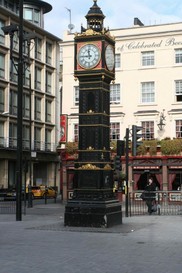 Everybody has heard of the Big Ben and ends up visiting it at some stage. Very few know that there is a miniature version of it on an emplacement at the crossroads between Vauxhall Bridge Road and Victoria Street. It consists of a tower in cast iron with a clock at the top, and effectively reproduces the design of the Big Ben which stands in Westminster Palace. It was placed here in 1892 by the company Gillett & Johnston, from Croydon, who built it. There are some verses engraved in it:
Everybody has heard of the Big Ben and ends up visiting it at some stage. Very few know that there is a miniature version of it on an emplacement at the crossroads between Vauxhall Bridge Road and Victoria Street. It consists of a tower in cast iron with a clock at the top, and effectively reproduces the design of the Big Ben which stands in Westminster Palace. It was placed here in 1892 by the company Gillett & Johnston, from Croydon, who built it. There are some verses engraved in it:My hands you may retard or may advance,
As my heart beats true for England and for France*
In Victoria, in the Seychelles, there is a copy of it which was placed in memory of Queen Victoria’s Golden Jubilee of 1897.
NEW SCOTLAND YARD
8-10 BROADWAY
UNDERGROUND: ST JAMES
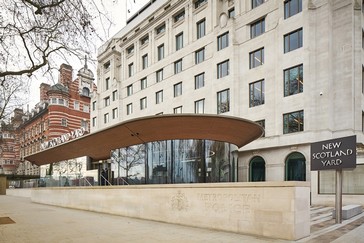 Scotland Yard is no longer to be found in this pretty house on the Embankment, and today what was once the original location is known as Norman Shaw Buildings. The name is that of an architect who built these two attractive buildings, which have a dignified air about them, at the beginning of the Twentieth Century for the Metropolitan Police. They are built in red bricks and white stone upon a granite base, in the Gothic-Victorian style. Since 1979, the two buildings, North and South, which were once connected by a bridge, have been used as offices for Members of Parliament. To this end, they have been restructured and readapted.
Scotland Yard is no longer to be found in this pretty house on the Embankment, and today what was once the original location is known as Norman Shaw Buildings. The name is that of an architect who built these two attractive buildings, which have a dignified air about them, at the beginning of the Twentieth Century for the Metropolitan Police. They are built in red bricks and white stone upon a granite base, in the Gothic-Victorian style. Since 1979, the two buildings, North and South, which were once connected by a bridge, have been used as offices for Members of Parliament. To this end, they have been restructured and readapted.THE ARMY AND NAVY SHOPS
101 VICTORIA STREET
UNDERGROUND: VICTORIA
These shops have an interesting history, and were a group of department stores which had their main quarters in Victoria Street. They started as a cooperative, built in 1871 by a group of army and navy officers, with the aim of providing articles of common use to those belonging to both military bodies. The price was intended to be as low as possible. At first it was only a grocery store, then later the sale of fabrics was added, along with spices and rifles. Today the shop is called House of Fraser and is a department store.
WESTMINSTER CATHEDRAL
42, FRANCIS STREET
UNDERGROUND: VICTORIA
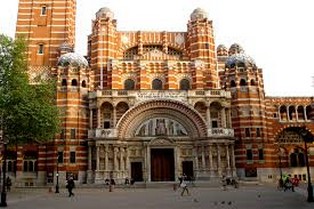 At the end of the Nineteenth Century, the archbishop of Westminster, cardinal Vaughan, decided to build a cathedral upon the spot where previously there stood a prison. He called for the architect John Francis Bentley, who had turned to Catholicism shortly after turning twenty. He was assigned with differentiating the style from that of Westminster Abbey, in order to avoid it resembling an imitation of the latter. The architect drew his inspiration from the Byzantine style. Its facade, on Ashley Place, is built in red bricks, with a series of decorations in white stone and a large arched portal. The majestic bell tower is almost as tall as that of the cathedral in Siena, to which it is inspired, and bears some strips of red bricks which alternate with others in white stone. The indoor area is rich and imposing. The walls and pillars are covered with mosaics and marble of a hundred different varieties from all over the world. In the south-western corner, there is a baptistery, with an enormous marble baptismal font, above which there is a mosaic which represents the four rivers of Heaven: the Tigris, the Euphrates, the Gihon, and the Pison. Together, they symbolize the waters of baptism. The mosaics on the wall, instead, portray the English saints, amongst which the venerable Bede.
At the end of the Nineteenth Century, the archbishop of Westminster, cardinal Vaughan, decided to build a cathedral upon the spot where previously there stood a prison. He called for the architect John Francis Bentley, who had turned to Catholicism shortly after turning twenty. He was assigned with differentiating the style from that of Westminster Abbey, in order to avoid it resembling an imitation of the latter. The architect drew his inspiration from the Byzantine style. Its facade, on Ashley Place, is built in red bricks, with a series of decorations in white stone and a large arched portal. The majestic bell tower is almost as tall as that of the cathedral in Siena, to which it is inspired, and bears some strips of red bricks which alternate with others in white stone. The indoor area is rich and imposing. The walls and pillars are covered with mosaics and marble of a hundred different varieties from all over the world. In the south-western corner, there is a baptistery, with an enormous marble baptismal font, above which there is a mosaic which represents the four rivers of Heaven: the Tigris, the Euphrates, the Gihon, and the Pison. Together, they symbolize the waters of baptism. The mosaics on the wall, instead, portray the English saints, amongst which the venerable Bede. In the southern nave, there is a chapel dedicated to St Paul, its pavement bearing a scholastic imitation of the work of the Cosmati. The pulpit has a number of marble inlay works and is adorned with the figures of the four Evangelists, which were carried out in Rome in 1899 by Leonori. They were donated to the cathedral in 1934 by the cardinal Bourne, in order to commemorate his thirty years of service here. On a pillar to the left, there is a bronze panel portraying Saint Therese of Lisieux, carried out by Giacomo Manzù. The altar is made of Cornish granite, and nearby stands the archbishop’s throne, inspired by that of the Pope in the Basilica of Laterano. Above it, there is a canopy, supported by eight pillars in Verona marble. All around the walls, there are bas-reliefs with the fourteen stations of the Way of the Cross, the work of the English sculptor Eric Gill. The bas-reliefs are so shallow that they give the impression of being mere engravings. A large dome looms above.
The city seen from above – The bell tower has a small platform from which one can enjoy a remarkable view. For those who wish to admire the city from above (a height of eighty-five metres) without facing the hundreds of steps which make up the staircase, as is the case at the dome in St Paul’s and at Monument, here we are presented with a conveniently-placed lift, installed in 1929. 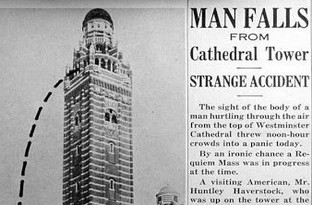 The starting point is slightly hidden, behind a small souvenir shop in the north-western corner. From the small overlook, one can see Buckingham Palace, the cathedral of St Paul’s, the towering building of British Telecom, the Canary Wharf skyscraper, and the Battersea power plant. In a film by Alfred Hitchcock, Foreign Correspondent, an assassin throws himself off this very bell tower whilst a requiem is being held inside.
The starting point is slightly hidden, behind a small souvenir shop in the north-western corner. From the small overlook, one can see Buckingham Palace, the cathedral of St Paul’s, the towering building of British Telecom, the Canary Wharf skyscraper, and the Battersea power plant. In a film by Alfred Hitchcock, Foreign Correspondent, an assassin throws himself off this very bell tower whilst a requiem is being held inside.
 The starting point is slightly hidden, behind a small souvenir shop in the north-western corner. From the small overlook, one can see Buckingham Palace, the cathedral of St Paul’s, the towering building of British Telecom, the Canary Wharf skyscraper, and the Battersea power plant. In a film by Alfred Hitchcock, Foreign Correspondent, an assassin throws himself off this very bell tower whilst a requiem is being held inside.
The starting point is slightly hidden, behind a small souvenir shop in the north-western corner. From the small overlook, one can see Buckingham Palace, the cathedral of St Paul’s, the towering building of British Telecom, the Canary Wharf skyscraper, and the Battersea power plant. In a film by Alfred Hitchcock, Foreign Correspondent, an assassin throws himself off this very bell tower whilst a requiem is being held inside.FROM PRISON TO PITCH
UNDERGROUND: VICTORIA
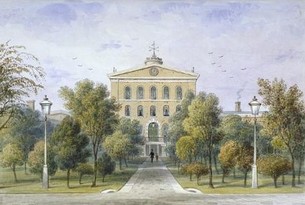 Vincent Square is the only part left of what was once Tothill Fields and today is used as a pitch for games. It is a large grassy square, used by students of Westminster School for sports activities. There is even a cricket pavilion. Vincent Square was created by the deacon Vincent, who used to teach in the adjacent school. When he realised that the buildings were starting to eat up all the available space, he purchased it, and today it is part of the school’s property, although it is almost always open.
Vincent Square is the only part left of what was once Tothill Fields and today is used as a pitch for games. It is a large grassy square, used by students of Westminster School for sports activities. There is even a cricket pavilion. Vincent Square was created by the deacon Vincent, who used to teach in the adjacent school. When he realised that the buildings were starting to eat up all the available space, he purchased it, and today it is part of the school’s property, although it is almost always open. This land was once occupied by the prison of Tothill Fields, which has been operative since 1618. The prison was rebuilt in 1834, in a four-leaf clover layout. Each “leaf” hosted roughly three hundred prisoners, both men and women, who were authorized to mingle. In the centre, there was a tree-lined yard.
THE GARDENER’S SOCIETY
80, VINCENT SQUARE
UNDERGROUND: VICTORIA
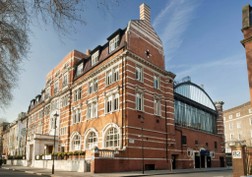 The Royal Horticultural Society was founded in 1804. It was John Wedgwood who suggested its creation, with the purpose of planning regular meetings and presenting paperwork on one’s activities and discoveries. At first, these meetings would take place in the Hatchards library. The society promotes the garden through exhibitions, also through the use of mini-models of the garden itself.
The Royal Horticultural Society was founded in 1804. It was John Wedgwood who suggested its creation, with the purpose of planning regular meetings and presenting paperwork on one’s activities and discoveries. At first, these meetings would take place in the Hatchards library. The society promotes the garden through exhibitions, also through the use of mini-models of the garden itself. The most famous exhibition to be partly organized by the association is the Chelsea Flower, however there are many others, amongst which the London Flower Show, which is held eight times a year, and where one can receive advice from experts, as well as purchase flowers and plants. Gardening is in fact greatly encouraged in England and there are campaigns aimed at involving a growing number of people, for the benefit of the community.
Furthermore, the society awards medals to those who have distinguished themselves in this field, such as the Victoria Medal of Honour. The headquarters contains a library, and its main core is made up of books donated by John Lindley.
TATE GALLERY
5, ATTERBURY STREET
UNDERGROUND: PIMLICO, VAUXHALL
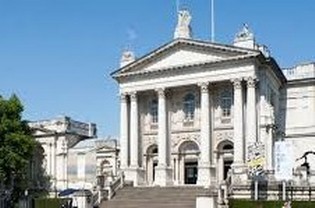 Four galleries are grouped under the ‘Tate’ name, two of which are in London. The one standing on Millbank was built in 1897, thanks to the donation of the sugar magnate, Henry Tate. On its lands stood a prison, the Penitentiary, which was demolished in 1890. The gallery hosts some collections of antique paintings (the oldest, by Bettes, dates back to 1515), as well as various works by Hogarth, Gainsborough, Reynolds, Constable, Blake, and the group of pre-Raphaelites, along with most of Turner’s works.
Four galleries are grouped under the ‘Tate’ name, two of which are in London. The one standing on Millbank was built in 1897, thanks to the donation of the sugar magnate, Henry Tate. On its lands stood a prison, the Penitentiary, which was demolished in 1890. The gallery hosts some collections of antique paintings (the oldest, by Bettes, dates back to 1515), as well as various works by Hogarth, Gainsborough, Reynolds, Constable, Blake, and the group of pre-Raphaelites, along with most of Turner’s works. It is famous for the beautiful exhibitions which are held there. The restaurant has an enchanting graffiti, The Expedition in Pursuit of Rare Meats, carried out by Rex Whistler in 1927, which gives the place a very original feel to it. Also the café brims with style.
It is enjoyable to reach the gallery with the Tate boat, which circulates between the Tate Modern, London Eye, and Tate Britain every forty minutes.
The area of Marylebone got its name from the church which once stood on the banks of a brook, the Tyburn, which provided the city with its water. This is testified by the plaque at number 50 of Marylebone Lane, which refers to a conduit dating back as far as 1776. Today this is a residential area and the only memory of this agricultural past is the weaving route taken by High Street, which follows the Tyburn, as did the road that once ran through the old village
During the Nineteenth Century, writers and artists used to live here, one of which was Turner, who lived in Queen Anne Street at number 23. In Marylebone lies the beautiful Cavendish Square, which was named after Henrietta Cavendish-Hollace, wife of the count of Oxford, who began its development. It is a tree-lined square, and one of its buildings bears a blue plaque, signifying that this was once the home of the founder of Westminster University. Cavendish square appears in the novel by Stevenson called Dr. Jekyll and Mr Hyde, in which it is the home of Dr. Lanyon, Jekyll’s best friend.
The century of Asia – The square is a good starting point for exploring the neighbourhood. At number 63, New Cavendish Street, stands Asia House, which has the purpose of “preparing the citizens of the United Kingdom for the century of Asia, by promoting the understanding between various cultures, religions, and forms of art, and favouring trade opportunities.” Among the hundreds of events that are held in its vast halls are exhibitions, seminars, shows, and festivals.
Park Square East contains one of the last hatches with a cover in cast iron, which used to be found at the sides of the street above the charcoal kilns. They were used to slide coal into the basement, where it was then stored. Another fascinating element that comes from the past is a small pillar, which is almost entirely covered in ivy, and is located in Peto Place. It is black and shiny, and stands out against the background of flowers, behind the gate. It marks the boundary between the parishes of St Marylebone and St Pancras.
THE CHURCH OF ST MARELYBONE
17, MARYLEBONE ROAD
UNDERGROUND: BAKER STREET
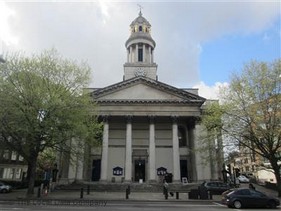 The church was built in 1817 following Thomas Hardwick’s design. It stands near the crossroads of the extremely busy Marylebone Road with Marylebone High Street. It is a huge building, with a looming Corinthian porch. The same area had already been the home of two previous churches. The layout is cross-shaped and the walls and ceiling, which are of a delicate tone of watery green, are rich with golden plasterwork. The bell tower is surmounted by a dome, which in turn is held up by golden caryatides cast by Charles Rossi.
The church was built in 1817 following Thomas Hardwick’s design. It stands near the crossroads of the extremely busy Marylebone Road with Marylebone High Street. It is a huge building, with a looming Corinthian porch. The same area had already been the home of two previous churches. The layout is cross-shaped and the walls and ceiling, which are of a delicate tone of watery green, are rich with golden plasterwork. The bell tower is surmounted by a dome, which in turn is held up by golden caryatides cast by Charles Rossi.Two poets on the run – There is a small separate room dedicated to the memory of Elizabeth Barrett and Robert Browning. After sending each other hundreds of letters, they had finally met and fallen in love. She was almost forty years old, and virtually disabled, whereas he was thirty-six. On 12th September 1846, they managed to elude the strict surveillance of her father, and headed to the church to get married secretly. One week later, they fled to Italy, never to return again to their country. Here, a document of their marriage is conserved. Today the room is used as a ceremonial hall. On the wall, there are some portraits of the two poets, and on the coloured glass panes of the windows, there are two angelical figures, with a black circle in between them, bearing the words: “In this church was solemnised the marriage of Robert Browning and Elizabeth Barrett on 12th September 1846”.

At its base, their initials are intertwined. On Sunday mornings, in the paved square just next to the church alongside High Street, there is a market, where one can also find delicious hot Sicilian sausages. This corner was chosen by Hogarth as a background for his painting of the wedding between Tom Rakewell and the Old Lady.
BBC BROADCASTING HOUSE
PORTLAND PLACE
UNDERGROUND: REGENT’S PARK, OXFORD CIRCUS
The building, headquarters of radio BBC, is rather bizarre. It has a narrow facade with a rounded entrance, making it somewhat resemble a ship, with its prow facing the centre of the city. High above, there is a clock tower. It was designed by Colonel G. Val Myer in 1932. It is built in Portland stone and is nine stories high. The central tower has is encircled by a protective steel structure, which has been nicknamed “the tower of Babel”, which deflects sounds and provides a better acoustic effect in general.
The statue above the entrance portrays Prospero and Ariel, two characters in Shakespeare’s comedy The Tempest. It was carried out by Eric Gill. The boy, Ariel, is naked, and at the time there were protests on account of the excessive size of his penis. Therefore John Reith, the general director of the BBC, ordered the sculptor to rectify the matter. The first programme to be broadcast from this site was Henry’s Hall’s show with his BBC dance orchestra.
The architect’s association – At number 66, Portland Place, stands the headquarters of the Royal Institute of British Architects, also known as the RIBA, for the sake of conciseness. It was founded in 1834 by a few architects, amongst which John Buonarrotti Papworth, born in Marylebone in 1775. Today it includes more than forty-thousand members. The building that hosts it has a simple white facade, which is smooth and shiny and was designed by George Grey Wornum in 1930. The sculpture above the window high above the main entrance goes by the title Architectural Aspiration, and is Copnall’s work. Part of the building is open to the public. The library is one of the most important in the world in this field. As well as books and magazines, there are photographs, drawings (including some by Palladium and Wren), and manuscripts. There are a café and some galleries used for exhibitions. The association assigns various awards, such as that for the best building of the year. It also awards a gold medal to those who have distinguished themselves for their work, or to those who have managed to prepare a low-cost project.
WALLACE COLLECTION
HERTFORD HOUSE - MANCHESTER SQUARE
UNDERGROUND: BOND STREET
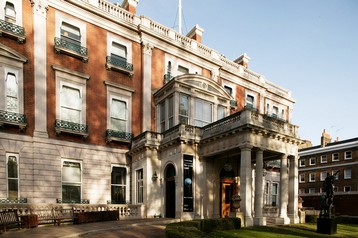 The museum’s collection includes many paintings from the golden period of Dutch painting and French art of the Eighteenth and Nineteenth Century, which are considered its main assets. It contains a work by Titian, the Perseus and Andromeda, two portraits of Van Dyck, and two panoramic views of Venice by Canaletto. It is a receptacle of the Ancien Régime, filled with furniture from the XVIII century, Sèvres porcelain, gilded bronze works, and many items of art. The collection of paintings includes two by Fragonard, as well as others by Delacroix, Géricault, Corot, and the delicate hand of Boucher and Watteau.
The museum’s collection includes many paintings from the golden period of Dutch painting and French art of the Eighteenth and Nineteenth Century, which are considered its main assets. It contains a work by Titian, the Perseus and Andromeda, two portraits of Van Dyck, and two panoramic views of Venice by Canaletto. It is a receptacle of the Ancien Régime, filled with furniture from the XVIII century, Sèvres porcelain, gilded bronze works, and many items of art. The collection of paintings includes two by Fragonard, as well as others by Delacroix, Géricault, Corot, and the delicate hand of Boucher and Watteau. There are also nine paintings by Rubens, two by Velàsquez, eight by Murillo, and five by Rembrandt, including one of his son Titus. It does not receive very many visits and would deserve to be more renowned, as there are few galleries in the world that can boast such a wealth of masterpieces.
THE MUSEUM OF THE ROYAL ACADEMY OF MUSIC
MARYLEBONE ROAD
UNDERGROUND: BAKER STREET
The museum is connected to the building of the music academy by an underground passage, which also links together the rooms where the students practice. The building was designed in 1822 by John Nash, however the inside area was destroyed by a bomb in 1940. The precious collection is made up of two hundred string instruments, whose maintenance is assigned to the tuning experts of the academy.
There are a few Stradivari models, some Amati, and some Guarneri (del Gesù). In 2005, the academy purchased the famous violin Viotti ex-Bruce. Also exhibited, are some archive documents, with letters, musical manuscripts, photographs, images, and illustrations. There are also some conductor’s batons, some scores for orchestra and piano, a number of instruments and forms of percussion, and an Alexander horn, restored from the damage wrought by the accident which took the player Dennis Brain’s life.
WIGMORE HALL
36 WIGMORE STREET
UNDERGROUND: BOND STREET
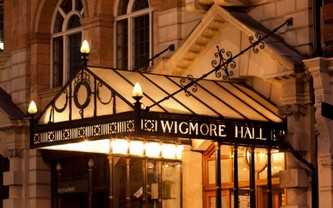 At first it was called Bechstein Hall. It was built by the German piano builder whose shop used to be next door. It has a Renaissance style, with marble and alabaster cladding, and a dome upon which the Soul of Music has been painted.
At first it was called Bechstein Hall. It was built by the German piano builder whose shop used to be next door. It has a Renaissance style, with marble and alabaster cladding, and a dome upon which the Soul of Music has been painted.The opening concert, which took place on 31st May 1901, was held by the pianist Ferruccio Busoni and by the violinist Eugène Ysaÿe. It immediately became a place of international fame, specialized in concerts for chamber music, in particular piano music, with players of top calibre, such as Rubinstein, Saint-Saëns, Richter, Ashkenazy, and Prokofiev. During the First World War, the building was confiscated by the enemy, then, after the war, reopened with its new name. The entrance is crowned by an iron and glass canopy, and supported by white pillars. 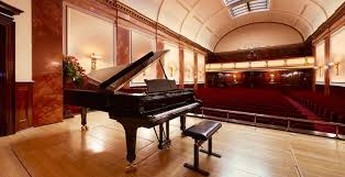 Wigmore Hall is both cosy and majestic, with an acoustic environment which nears perfection, and which has made its name, and through the years has attracted artists from all over the world. An average of four hundred concerts are held here every year, and there is even a weekly one broadcasted by BBC Radio 3. The concerts are recorded live and become published records of the Wigmore Hall Live. There is also an intense programme for schools, including concerts for children under the age of five.
Wigmore Hall is both cosy and majestic, with an acoustic environment which nears perfection, and which has made its name, and through the years has attracted artists from all over the world. An average of four hundred concerts are held here every year, and there is even a weekly one broadcasted by BBC Radio 3. The concerts are recorded live and become published records of the Wigmore Hall Live. There is also an intense programme for schools, including concerts for children under the age of five.
 Wigmore Hall is both cosy and majestic, with an acoustic environment which nears perfection, and which has made its name, and through the years has attracted artists from all over the world. An average of four hundred concerts are held here every year, and there is even a weekly one broadcasted by BBC Radio 3. The concerts are recorded live and become published records of the Wigmore Hall Live. There is also an intense programme for schools, including concerts for children under the age of five.
Wigmore Hall is both cosy and majestic, with an acoustic environment which nears perfection, and which has made its name, and through the years has attracted artists from all over the world. An average of four hundred concerts are held here every year, and there is even a weekly one broadcasted by BBC Radio 3. The concerts are recorded live and become published records of the Wigmore Hall Live. There is also an intense programme for schools, including concerts for children under the age of five.THE MOSQUE AT REGENT’S PARK
146, PARK ROAD
UNDERGROUND: BAKER STREET
The London Central Mosque is also known as the Islamic Cultural Centre.
It was designed by the architect Frederick Gibberd and was completed in 1978. The large hall of the main building can host up to five thousand people. The women pray in the upper gallery.
The indoor area is decorated with the shapes of Islamic tradition, and the golden dome shines amid the tree branches. In the lateral wings, there are a library with a reading room, some offices, and the minaret. What is more, there is a pretty library and a café.
THE FOUNDERS OF THE ZOO
REGENT’S PARK
UNDERGROUND: REGENT’S PARK
THE LONDON ZOO
REGENT’S PARK
UNDERGROUND: CAMDEN TOWN, CHALK FARM
The public opinion with regards to animals held in captivity has changed over time. It cannot be forgotten, in fact, that the zoo is a prison for the animals, no matter how well they are treated and cared for. Children, however, continue to adore the place. Waiting for them at the London Zoo, are animals who have been named. Some examples are Thug, the pygmy hippopotamus, Lumpur the Sumatra tiger, Ricky the jumping penguin, Lucifer the lion, Mjukuu the gorilla, Ellis the giraffe, Raja the Komodo dragon, and Bounty the monkey. There are a reptilery, an aquarium, an insect house, and even a zoo area for children.
There are a number of theme-driven paths, such as In Africa or The butterflies’ paradise. The bird house is a sort of charming, melodic tropical forest, with kookaburras, lovebirds, humming birds, and a dove which is the last specimen of an extinct breed. The penguin house, built in 1934 by Berthold Lubetkin, is an icon of modern architecture, almost a sculpture.
The fish in the aquarium have been bred in the context of a conservation project and there is a rebuilt coral reef, with vividly coloured tropical fish swimming in and around it. Another tank contains electric eels and lungfish. It is the oldest zoo in the world, and the collection at that time included some of the animals which are now extinct. It is also one of the largest. One department of the aquarium, called the Big Fish Tank, hosts fish from the private homes of people who realize that they are no longer able to care for them. Unlike New York, where it would seem that crocodiles are thrown into the drains by their owners and grow to reach gigantic proportions in the sewers, here they are brought to the zoo.
THE ROYAL COLLEGE OF PHYSICIANS
ST ANDREWS PLACE
UNDERGROUND: GREAT PORTLAND STREET
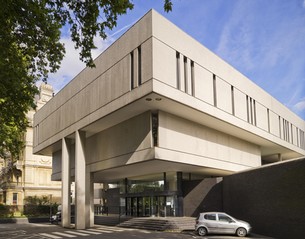 The institution of the Royal College of Physicians was founded in 1518, with the aim of offering the right of practice to those with a medical qualification, as well as punishing unauthorized practice. It is still today one of the most active medical organizations. Its first headquarters, near the St Paul’s cathedral, in Amen Corner, was destroyed in the Great Fire of 1666. The school has always taken care of the publishing of volumes such as the London Pharmacopoeia, written in Latin, aimed at regulating the composition of medicines and texts with the nomenclature of illnesses. The place hosts a noteworthy collection connected to the history of medicine. There are portraits, surgical tools, especially dating back to the Eighteenth and Nineteenth century, commemorative medals, anatomical tables with arteries and veins painted red and blue.
The institution of the Royal College of Physicians was founded in 1518, with the aim of offering the right of practice to those with a medical qualification, as well as punishing unauthorized practice. It is still today one of the most active medical organizations. Its first headquarters, near the St Paul’s cathedral, in Amen Corner, was destroyed in the Great Fire of 1666. The school has always taken care of the publishing of volumes such as the London Pharmacopoeia, written in Latin, aimed at regulating the composition of medicines and texts with the nomenclature of illnesses. The place hosts a noteworthy collection connected to the history of medicine. There are portraits, surgical tools, especially dating back to the Eighteenth and Nineteenth century, commemorative medals, anatomical tables with arteries and veins painted red and blue. Each object shows how the average health of mankind is continuously improving. The present office dates back to 1964 and has a fascinating T-shape to it, with two floors supported by pillars. The top floor is wider than the bottom. There is a lecture hall for conferences, and the most important of them has been held regularly since 1582, and is called Lumleian Lecture.
Collections are open to the public through booking.
In the square stands a beautiful statue of the philanthropist Quintin Hogg, depicted in the act of reading a book to two boys, one of which is holding a ball under his arm. It suggests that also sport is important and should not be neglected.
LORD’S CRICKET MUSEUM
ST JOHN’S WOOD ROAD
UNDERGROUND: ST JOHN’S WOOD
The cricket pitch Lord’s, which bears the name of its founder, the wine merchant Thomas Lord, is one of the oldest stadiums in the world. It was created in 1814 around a stagnant water well. It is also one of the most prestigious pitches, having hosted the finals of the World Cup on four occasions. The "cricket house" is built in bricks, has two large lateral towers, and is quite peculiar. It is owned by the Marylebone Cricket Club. The club also possesses a small art gallery and a sports museum, which is the oldest of its kind to exist in the whole world. A number of guided visits can be followed amid the souvenirs.
There are some important paintings, one of which, a Flemish work, portrays David and Bathsheba, and shows tennis being played in the background. There is also a painting by Pietro Fabris, which depicts a game of football, a portrait of Thomas Hope playing cricket by Jacques-Henri Sablet, painted while the future connoisseur was on the Grand Tour in Amsterdam. Another attraction is the collection of bats signed by the champions who once used them, along with photos, and printed material regarding the matches of the past. In the Memorial Gallery there is also a fascinating item: a stuffed sparrow chick which died on the pitch has been placed above the ball that took its life. The creature had been unlucky enough to pass through the trajectory of a balled thrown by Jehangir Khan in 1936. It is worth taking a look at the Long Room, where the “rich and famous” meet when there is an important meeting. The Queen, instead, follows the matches from the Committee Room. Sports journalists follow the match from a cabin placed high above the pitch.
A PANORAMIC DIORAMA
PETO PLACE
UNDERGROUND: REGENT’S PARK
The diorama was a form of show made up of paintings or views of great size, which were illuminated via various technical mechanisms, giving the spectator the illusion of being in the wake of a real panorama and its shifting play of lights. The subjects of the diorama could be military or biblical themes, such as the battle of Trafalgar. Louis-Jacques-Mandé Daguerre was its inventor.
The Peto Place Diorama was designed at the end of 1823 for an audience of two hundred people and cost nine thousand pounds. Spectators would watch the screen as if they were at the end of a tunnel, and every quarter of an hour a bell would announce that a change of scene was about to take place. The building is quite a sight, with its enormous windows, and today still stands in Peto Place. It closed as a diorama in 1851. After that, it was used as a baptism chapel and as a clinic. The street is dedicated to Samuel Morton Peto, who was a railway engineer. He was a Baptist and a generous benefactor of the church.
THE STATION AND THE SHERLOCK HOLMES MUSEUM
BAKER STREET
UNDERGROUND: BAKER STREET
The museum is hosted in a house dating back to 1815, similar to that of the fictional story, and the address used is the same as that of the book, although there have been a number of bureaucratic difficulties and a long disagreement with the insurance company Abbey National before this became possible. The persistent claim of imposing this address was targeted a number of times by satirical writers. The museum, which finally opened in 1990, recreates the Victorian indoor style, with red velvet, Damascus silk, solid dark furniture, wooden floorboards covered with rugs, a chimney place, and a pendulum which loudly and incessantly marks the passing of time... Along with other items from the epoch, there are wax statues and Holmes’ personal memorabilia.
QUEEN MARY’S ROSE GARDEN
AT THE CENTRE OF THE INNER CIRCLE
The rose garden was fulfilled in order to celebrate the anniversary of George V and Queen Mary in 1935. It has been arranged following a circular design, which was that of the available space. The plants renewed in the Nineties of the previous century by the garden architects Colvin and Moggridge. A number of new ones have been added, to the point that there are now over thirty thousand of at least four hundred different varieties.
Their wonderful sweet-smelling buds decorate and give a pleasant scent to this area, which is the quintessence of an English garden. The ideal moment to visit it is halfway through June, when the different varieties are in full bloom. It is ideal for passing an afternoon or two, surrounded by flowers and fountains, whilst taking a stroll along the boulevards. If flowers, trees, animals, and London parks are one’s passion, and one wishes to take part in a good deed, here one may adopt a flower, a deer, or a duck belonging to another park, and help with their upkeep.
OPEN AIR THEATRE
NORTH WEST OF THE INNER CIRCLE
The open air theatre was founded in 1932 by Sydney Carroll and Robert Atkins. The season lasts four to five months, from May to September, with the rotation of four shows. One of them is A Midsummer Night’s Dream, another is Shakespeare’s second work, a third is a musical, and a fourth is a children’s show. The stage is made up of a stone platform, with two crooked walls at the back, behind which are the rooms hosting the laboratories and the sound and light technicians.
Being out in the open, the shows all depend on the weather conditions. Sometimes the plays are suspended and then later continued, as soon as the rainy spell ends. It is said that the spectators’ restaurant has the longest counter ever to be seen in a theatre. Meals are served starting from one and a half hours before shows, during the intervals and after the shows. There is even a barbecue, and for those bringing their food from home, there is a nearby picnic area, equipped with tables and chairs. It is an experience that should definitely not be passed up.
INNER CIRCLE
SOUTHERN-CENTRAL AREA OF REGENT’S PARK
The Inner Circle unsurprisingly forms a circle, within which the Queen’s gardens and a lake are enclosed. It is enjoyable to go for a picnic on the eastern side of St John’s Ledge, amid its flower compositions, stone fountains, and velvety fields. One might then continue with a walk along the Outer Circle, towards Primrose Hill, along Regent’s Canal.
From the top of the hill one can enjoy a pretty view of London, starting with St Paul’s cathedral. The roads that climb up towards the top are flanked by small houses in the Georgian or Edwardian style. Some of them bear blue plaques. The famous poet Sylvia Plath once lived at number 3, Chalcot Square. Unfortunately many great trees that used to stand in this area were blown down by the hurricane of 1978, however those that were planted as a replacement have now reached a remarkable size. 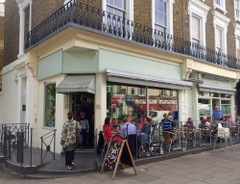 The hill’s summit is the preferred place of kite flyers. There was a time when deadly duels would take place here. In the distance, one can make out the animals in the zoo.
The hill’s summit is the preferred place of kite flyers. There was a time when deadly duels would take place here. In the distance, one can make out the animals in the zoo.
 The hill’s summit is the preferred place of kite flyers. There was a time when deadly duels would take place here. In the distance, one can make out the animals in the zoo.
The hill’s summit is the preferred place of kite flyers. There was a time when deadly duels would take place here. In the distance, one can make out the animals in the zoo.To recover from the hike up the hill, one may drink some excellent coffee at Cachao, at number 140, Regent’s Park Road, and nibble at a pancake. Weather permitting, it is lovely to sit outdoors. Just nearby, there is also a shop selling toys and chocolate.
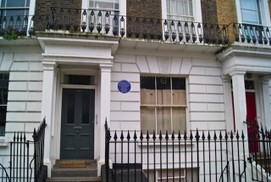 Engels’ House – At number 134, Regent’s Park Road stands the Primrose Hill Books bookshop. It is the best sales point for new and second-hand books. Here one can find old books of precious content, which are impossible to find elsewhere.
Engels’ House – At number 134, Regent’s Park Road stands the Primrose Hill Books bookshop. It is the best sales point for new and second-hand books. Here one can find old books of precious content, which are impossible to find elsewhere. 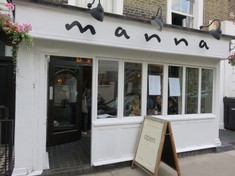 The nearby house bears a blue plaque which indicates that Engels once lived here. As far as restaurants go, here one can find Odette’s, a refined place with an outside area. For vegetarians, at number 4, Erksine Road, there is a restaurant called Manna, which serves dishes which resemble sculptures, such is their sophistication.
The nearby house bears a blue plaque which indicates that Engels once lived here. As far as restaurants go, here one can find Odette’s, a refined place with an outside area. For vegetarians, at number 4, Erksine Road, there is a restaurant called Manna, which serves dishes which resemble sculptures, such is their sophistication.The canal which used to surround the inhabited area and extend from Paddington Basin to Uxbridge was built in 1805. Later on, the arrival of the Great Western railway in 1838 brought about the construction of many new houses along Warwick Avenue, Clifton Gardens, and Maida Vale, north of the canal, however this was destined to lose its importance.
Paddington Station was built by Isambard Brunel. On 13th June 1842 Queen Victoria arrived, after having travelled seventeen miles in twenty-three minutes, from Slough. Brunel awaited her on the platform. The queen was arriving from a temporary terminal, whereas the final terminal was built in 1854, also following Brunel’s design, with three long arches in steel and iron. Up above, near platform number 1, there used to be an iron balcony belonging to Brunel’s office, from which the engineer would observe the activity going on below.
In Willesden Green stands St Magdalen’s church. It was built in 1878 on the steep slope of the canal. It is small, with a round tower, and a choir which curves inwards deeply. Because of the steepness of the bank, one of the lateral naves is missing, yet this asymmetric indoor layout grants it near perfect acoustic properties, which greatly benefits John Comper’s organ, which dates back to 1933, and the church is rightly famous for its high-quality concerts. In the crypt, there is a chapel, built in 1895. 4.50 from Paddington is a famous detective story by Agatha Christie.
TYBURN
UNDERGROUND STATION: MARBLE ARCH
At the beginning of the Nineteenth Century, the name Tyburnia used to indicate the south-western corner of the parish. The name was probably adopted because it was already very well known as a reference to the gallows beneath the Tyburn tree. The exact spot where it used to stand is commemorated by a metal triangle fixed to the base of the street in Marble Arch, near the park. This spot was chosen due to the fact that here, at the entrance of the two main roads into London, there used to be a group of elms. It was from their robust branches that, starting in 1196, the condemned would be hung, well in sight of passers-by. This place of hanging was known as Triple Tree and those who walked up its steps were mostly criminals or petty wrongdoers, however at times it was innocent people who would meet their doom.
During the Reformation, many Catholic martyrs were hanged here. In 1571, a proper gallows was built in the form of a triangular structure. Often there would be a great crowd attending the executions. For example, there were two hundred thousand present at Jack Sheppard's excecution. Sheppard had been a very promising twenty-one-year-old carpenter, who had been condemned to death for having escaped from prison six times. The first of these escapes had taken place just three hours after his capture. It is likely that his craft had aided him, considering that he had escaped through a hole in the ceiling, and then lowered himself using a knotted sheet. For one of the following escapes he had disguised himself as a woman.
He became something of a legend and a number of ballads and musical comedies have been dedicated to him. Seeing an engraving of him which has survived is somewhat endearing: he looks so young and afraid, wearing an elegant shirt with a bow tie and a jacket with a folded seam at the back....
Also the unearthed corpse of Cromwell had been exhibited in Tyburn. In 1783, the gallows was moved to Newgate.
A memorial museum – At numbers 8-12 of Hyde Park Place, where the gallows once stood, there was once a Benedictine seclusion convent, the Tyburn Convent. It is the house founded in 1901 by Marie Adèle Garnier who ordered that the relics of the martyrs of Tyburn be placed in the crypt: bones, hair, and blood-stained clothing.
There are three guided visits each day. The gallows, which used to be located where the streets of Bayswater Road and Edgware Road now meet, was assembled above the altar. Also part of the convent, is a house that barely exceeds one meter in width, which was built at the start of the Nineteenth Century.
In 1827, in Edgware Road, an elegant group of buildings was built, and named Tyburnia, despite the sinister association of such a name.
HORSEMAN’S SUNDAY
HYDE PARK CRESCENT
UNDERGROUND: PADDINGTON, MARBLE ARCH
In the lush, green area in front of St John’s church, every next-to-last Sunday in September at midday, a fascinating ceremony known as Horseman’s Sunday takes place. At the end of the service, the vicar blesses the knights, who have gathered in front of the church. Then, after having donned a long green cape with a yellow lining, he too mounts a steed and guides a procession of knights and horses (usually around a hundred of them) of all different sizes and colours, ranging from small ponies with lightly coloured fur to stallions with an imposing build.
The vicar then goes on to thank all the animals, who "make our stay on this Earth all the more pleasant". The origin of this ceremony dates back to 1968, when there was a desire to bring people’s attention to the need to maintain the function of the stables along the north side of Hyde Park. 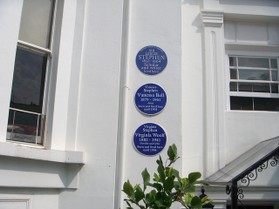 It has now become more of a festival which attracts residents and newcomers, also thanks to the fact that after the ride, there are a good many sweet things to be eaten.
It has now become more of a festival which attracts residents and newcomers, also thanks to the fact that after the ride, there are a good many sweet things to be eaten.
 It has now become more of a festival which attracts residents and newcomers, also thanks to the fact that after the ride, there are a good many sweet things to be eaten.
It has now become more of a festival which attracts residents and newcomers, also thanks to the fact that after the ride, there are a good many sweet things to be eaten. Along Hyde Park Gate, stand a great many tall, elegant houses, decorated with wreaths and plaster festoons, which envelop the walls and facades. Number 22 of this very street is where Virginia Woolf was born.
AN ARCHITECT SERVING GOD AT ST JAMES
SUSSEX GARDENS
UNDERGROUND: PADDINGTON
The architect George Edmund Street was a very religious person, who was specialized in designing clerical buildings. His belief was that an architect should be at the service of God, who had endowed him with such creativity. Because of this, his style must be synonymous with his moral dignity. The church of St James is located in the south-western corner of Sussex Gardens, in a spectacular place. Baden-Powell was baptised in this spot. The indoor area has a truly splendid lighting which is incredibly evocative.
In the nearby hospital of St Mary’s, in Praed Street, Alexander Fleming discovered penicillin. Bayswater Road is a pretty street which it is worth following on foot, from Marble Arch to Notting Hill Gate. At number 100 there is a house where James Barrie used to live, the creator of Peter Pan. It is occasionally open to the public. The construction of Orme Square, which was devised by the architect Edward Orme, began in 1816, when Tsar Alexander was visiting England, after the end of the wars against Napoleon. Because of this, the surrounding streets have names such as Petersburg Place and Moscow Road.
In the latter, stands the Greek-Orthodox cathedral of St Sophia, built in 1922. It is built in the Byzantine style, made of bricks, and following a Greek cross plan, with a central dome covered by mosaics. All are welcome here, and it is quite worth the effort of attending a service, if only to witness the choir’s impressive singing.
ALEXANDER FLEMING’S LABORATORY
PRAED STREET
UNDERGROUND: PADDINGTON
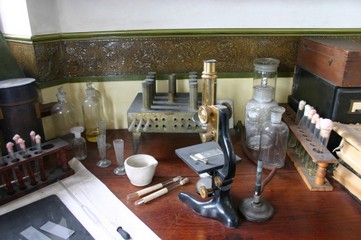 Within St Mary’s Hospital there is a small museum which is a reconstruction of what was once the laboratory belonging to the Scottish doctor Alexander Fleming. Here, in 1928, the doctor discovered the effects of the mushroom extract to which he gave the name of penicillin. It is an extremely effective ingredient against bacterial infections, one of the most potent to exist, and which has defeated illnesses such as tuberculosis, gangrene, and syphilis. There is also a video which retells the story of this discovery which revolutionized the history of medicine and gave birth to an enormous expansion of the pharmaceutical industry.
Within St Mary’s Hospital there is a small museum which is a reconstruction of what was once the laboratory belonging to the Scottish doctor Alexander Fleming. Here, in 1928, the doctor discovered the effects of the mushroom extract to which he gave the name of penicillin. It is an extremely effective ingredient against bacterial infections, one of the most potent to exist, and which has defeated illnesses such as tuberculosis, gangrene, and syphilis. There is also a video which retells the story of this discovery which revolutionized the history of medicine and gave birth to an enormous expansion of the pharmaceutical industry. In order to reach the laboratory-museum, one must pass through Norfolk Place.
PADDINGTON WATERSIDE
UNDERGROUND: PADDINGTON, EDGWARE ROAD
The Paddington Basin was the terminus of the canal known as Paddington Arm, which opened in 1801. The place was chosen for its position on the New Road, in order to activate the eastbound transport. In its golden period, Paddington was a centre of great activity. Later on, in the year 2000, British Waterways decided that a good percentage of the basin should be drained. Today, it is at the centre of a large restructuring operation.
The project is called Paddington Waterside and is an incentive for the construction of buildings at its borders. These tall buildings are extremely modern, and have an original design. Amid them, are some groups of sculptures and sports facilities.
This is the place where, in 2004, the Rolling Bridge was built, after having been designed by Thomas Heatherwick. It is a bridge which is capable of extending itself in order to allow pedestrians to cross the Grand Union Canal.
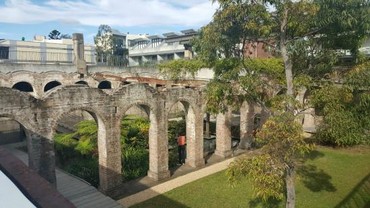 On foot or by boat – An itinerary for a pleasant walk could be the one starting in Hayes, which can be reached by train. From there, one can walk towards the canal. The first place one reaches is the Nestlé factory, just after Bull’s Bridge, wherefrom a pleasing scent of coffee spreads out. It is at the end of the Paddington Canal. The path passes through a number of rural areas, as well as others which are more dense with industrial archaeology. A very pretty feature is the aqueduct, which transports the canal water over the North Circular Road, near the underpass of Hanger Lane.
On foot or by boat – An itinerary for a pleasant walk could be the one starting in Hayes, which can be reached by train. From there, one can walk towards the canal. The first place one reaches is the Nestlé factory, just after Bull’s Bridge, wherefrom a pleasing scent of coffee spreads out. It is at the end of the Paddington Canal. The path passes through a number of rural areas, as well as others which are more dense with industrial archaeology. A very pretty feature is the aqueduct, which transports the canal water over the North Circular Road, near the underpass of Hanger Lane. One arrives in view of Wembley stadium, amid the factories of Park Royal. Then one reaches the Kensal Green cemetery, and continuing under the Westway flyover, one arrives at the basin, near the train station. Another option, during the summer months, is to take some trips from Paddington Basin to Camden Lock aboard one of the barges, two of which are named Jason and Jenny Wren. Between 1862 and 1887, the poet Robert Browning lived in the nearby Warwick Crescent, at number 19, and it is said that it was he who suggested planting the willows that surround the little island at the centre of the basin.
THE GASOMETER OF KENSAL GREEN
GRAND UNION CANAL
UNDERGROUND: KENSAL GREEN
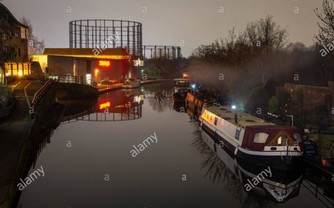 For those who are interested in industrial archaeology, the vestiges of this gasometer, which has now been eroded by rust, are quite interesting, as they are the testimony of an epoch. Pickaxes have not yet reached this spot, and there is some discussion about installing a museum that could tell of the history of the place, and recover and transform the gasometers. Their construction began at the end of the Nineteenth century, near the canals. Each one consisted of an actual plant for the production of gas and a number of cylindrical tanks, upon which a series of large quadrants indicated the amount of gas contained at that time. The diameter of the gasometers is around seventy meters, whereas their height is of forty. The tanks were capable of containing nearly one hundred thousand cubic metres of gas. This was produced by gas which was given off by coal, when the latter was heavily heated without being burnt.
For those who are interested in industrial archaeology, the vestiges of this gasometer, which has now been eroded by rust, are quite interesting, as they are the testimony of an epoch. Pickaxes have not yet reached this spot, and there is some discussion about installing a museum that could tell of the history of the place, and recover and transform the gasometers. Their construction began at the end of the Nineteenth century, near the canals. Each one consisted of an actual plant for the production of gas and a number of cylindrical tanks, upon which a series of large quadrants indicated the amount of gas contained at that time. The diameter of the gasometers is around seventy meters, whereas their height is of forty. The tanks were capable of containing nearly one hundred thousand cubic metres of gas. This was produced by gas which was given off by coal, when the latter was heavily heated without being burnt.In early times, the gas was needed for the lighting of streets and public buildings. Only after a few years did the gas also start to be used for the purpose of cooking.
A MONUMENTAL CEMETERY
HARROW ROAD
UNDERGROUND: KENSAL GREEN
Kensal Green Cemetery is one of the seven monumental cemeteries in London, and also the oldest. It was opened in 1833 and fulfilled following the canons of the French cemetery of Père Lachaise. The designs for its project were later used for the construction of other cemeteries throughout the British Empire. There are angels along the northern bank, which contribute to making it look somewhat like a country graveyard.
Somewhere near two hundred and fifty people have been buried here, of which one thousand belong to the London nobility or are celebrities. This is the resting place of the engineer Brunel and the writers Thackeray and Trollope.
The duke of Sussex was its first guest in 1843, and set the good example for many to come. In December 2008, the great playwright who won the Nobel Prize, Harold Pinter, was buried here, and also here is Freddy Mercury, the leader of the rock band Queen. Along with the beautiful mausoleums and funeral monuments on the surface, there are catacombs below the Anglican chapel, where guides accompany the visitors.
It is advisable to bring along a torch so that one can make out the finer details, which are sometimes a little macabre, other times quite interesting. There is a winch for lowering coffins down from the chapel, after the funeral service. There are also some fake flowers in copper and porcelain. Each Sunday there is a guided visit, and books can be bought which tell of the history of the cemetery. At the end of the tour tea and biscuits await.
CROCKER’S FOLLY
24 ABERDEEN PLACE
UNDERGROUND: WARWICK AVENUE
It is a beautiful house with the saddest of stories. By the end of the Nineteenth century, the construction of the Great Central Railway line was almost complete. Someone had told Frank Croker that the line would end at Aberdeen Place, in Lisson Grove, therefore he decided to build a hotel for travellers precisely on the corner of that square. It was an ornate building with many frills to it, with decorations built in bricks and freestones, windows in white plaster and arches in the Moorish style.
He had marble chimneys installed in the indoor area, cherubs painted on the ceiling, inlaid glasswork added, and the rooms furnished with prized items in mahogany. However, unfortunately the terminal ended up being built almost a mile away, in Marylebone. As soon as he found out, Frank headed up to one of the richly-decorated rooms and hanged himself. In the beautiful house, located in the heart of the elegant neighbourhood of St John’s Wood, a pub-restaurant has been opened.

